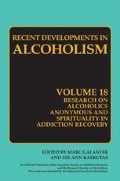Access this chapter
Tax calculation will be finalised at checkout
Purchases are for personal use only
References
Alcoholics Anonymous World Services. (1992). Alcoholics Anonymous (4th ed.). New York: Author.
Brandsma, J. M., Maultsby, M.C., Jr. & Welsh, R.J. (1980). Outpatient treatment of alcoholism: A review and comparative study. Baltimore: University Park Press.
Brown, B. S., O' Grady, K. E., Farrell, E. V., Flechner, I. S., & Nurco, D. N. (2001). Factors associated with frequency of 12-Step attendance by drug abuse clients [Special issue]. American Journal of Drug and Alcohol Abuse, 27(1), 147–160.
Carroll, J. L., & Fuller, G. B., (1969). The self and ideal-self concept of the alcoholic as influenced by length of sobriety and/or participation in Alcoholics Anonymous. Journal of Clinical Psychology, 25, 363–364.
Cloud, R. N., Ziegler, C. H., & Blondell, R. D. (2004). What is Alcoholics Anonymous affiliation? Substance Use & Misuse, 39, 1117–1136.
Ditman, K. S., Crawford, G. G., Forgy, E. W., Moskowitz, H., & MacAndrew, C. (1967). A controlled experiment on the use of court probation for drunk arrests. American Journal of Psychiatry, 124, 160–163.
Emrick, C. D., Tonigan, J. S., Montgomery, H. A. & Little, L. (1993). Alcoholics Anonymous: What is currently known? In B. S. McCrady, & W. R. Miller (Eds.), Research on Alcoholics Anonymous: Opportunities and alternatives (pp. 41–76). New Brunswick, NJ: Rutgers Center on Alcohol Studies.
Humphreys, K., & Moos, R. (2001). Can encouraging substance abuse patients to participate in self-help programs reduce demand for health care? A quasi-experimental study. Alcoholism, Clinical and Experimental Research, 25, 711–716.
Kaskutas, L. A., Bond, J., & Humphreys, K. (2002). Social networks as mediators of the effect of Alcoholics Anonymous. Addiction, 97, 891–900.
Kelly, J. F., Stout, R., Zywiak, W., & Schneider, R. (2006). A 3-Year study of addiction mutual-help group participation following intensive outpatient treatment. Alcoholism: Clinical and Experimental Research, 30, 1381–1392.
Montgomery, H. A., Miller, W. R., & Tonigan, J. S. (1995). Does Alcoholics Anonymous involvement predict treatment outcome? Journal of Substance Abuse Treatment, 12(4), 241–246.
Moos, R. H., & Moos, B. S. (2006). Participation in treatment and Alcoholics Anonymous: A 16-year follow-up of initially untreated individuals. Journal of Clinical Psychology, 62, 735–750.
Ogborne, A. C., & Glasner, F. B. (1981). Characteristics of affiliates of Alcoholics Anonymous. Journal of Studies on Alcohol, 42(7), 661–675.
Ouimette, P. C., Moos, R. H., & Finney, J. W. (1998). Influence of outpatient treatment and 12-step group involvement on one-year substance abuse treatment outcomes. Journal of Studies on Alcohol, 59, 513–522.
Ouimette, P. C., Gima, K., Moos, R. H., & Finney, J. W. (1999). A comparative evaluation of substance abuse treatment IV: The effect of comorbid psychiatric diagnoses on amount of treatment, continuing care, and 1-year outcomes. Alcoholism: Clinical and Experimental Research, 23, 552–557.
Pagano, M. E., Friend, K. B., Tonigan, J. S., & Stout, R. (2004). Sponsoring others in Alcoholics Anonymous and avoiding a drink in the first year following treatment: Findings from Project MATCH. Journal of Studies on Alcohol, 65, 766–773.
Project Match Research Group. (1997a). Matching alcoholism treatments to client heterogeneity: Project MATCH Posttreatment drinking outcomes. Journal of Studies on Alcohol, 58(1), 7–29.
Project Match Research Group. (1997b). Project Match secondary a priori hypotheses. Addiction, 92(12), 1671-1698.
Rawson, R. A., Obert, J. L., McCann, M. J., Castro, F. G., & Ling, W. (1994). Cocaine abuse treatment: A review of current strategies. Journal of Substance Abuse, 3, 457–491.
Timko, C., Moos, R. H., Finney, J. W., & Lesar, M. (2000). Long-term outcomes of alcohol use disorders: Comparing untreated individuals with those in Alcoholics Anonymous and formal treatment. Journal of Studies on Alcohol, 61, 259–540.
Tonigan, J. S., Connors, G. J., & Miller, W. R. (2003). Participation and involvement in Alcoholics Anonymous. In T. Babor, & F. DelBoca, (Eds.), Treatment matching in alcoholism. Cambridge: Cambridge University Press.
Weiss, R. D., Griffin, M. L., Najavits, L. M., Hufford, C., Kogan, J., Thompson, H. J., et al. (1996). Self-help activities in cocaine dependent patients entering treatment: Results from the NIDA collaborative cocaine treatment study. Drug and Alcohol Dependence, 43, 79–86.
Weiss, R. D., Griffin, M. L., Gallop, R., Luborsky, L., Siqueland, L., Frank, A., Onken, L. S., Daley, D. C., & Gastfriend, D. R. (2000). Predictors of self-help group attendance in cocaine dependent patients. Journal of Studies on Alcohol, 61, 714–719.
Zemore, S. E., Kaskutas, L. A., & Ammon, L. N. (2004). In 12-step groups, helping helps the helper. Addiction, 99, 1015–1023.
Author information
Authors and Affiliations
Corresponding author
Editor information
Editors and Affiliations
Rights and permissions
Copyright information
© 2008 Springer Science+Business Media, LLC
About this chapter
Cite this chapter
Scott Tonigan, J. (2008). Introduction. In: Kaskutas, L., Galanter, M. (eds) Recent Developments in Alcoholism. Recent Developments in Alcoholism, vol 18. Springer, New York, NY. https://doi.org/10.1007/978-0-387-77725-2_19
Download citation
DOI: https://doi.org/10.1007/978-0-387-77725-2_19
Published:
Publisher Name: Springer, New York, NY
Print ISBN: 978-0-387-77724-5
Online ISBN: 978-0-387-77725-2
eBook Packages: MedicineMedicine (R0)

